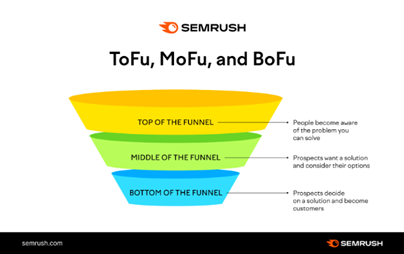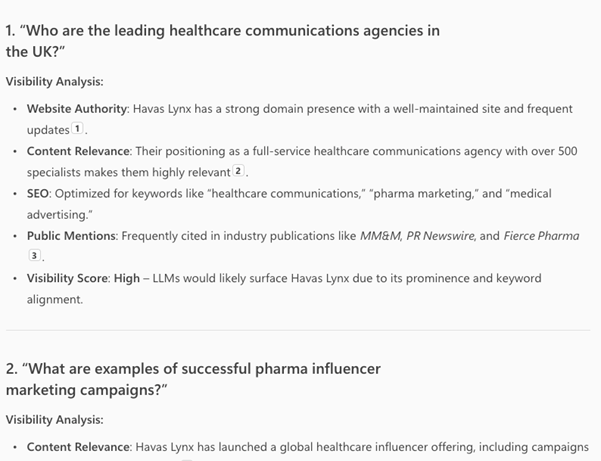3rd October 2025
BlogReporting on what matters
Rachael McLoughlin, Experience Director
In a previous article, we talked about the changing shape of online information discovery. The landscape is undoubtedly shifting – and rapidly, too. With this in mind, it’s important that brands understand the changing landscape of search, how this might impact their marketing efforts, and what they can do about it. That’s where generative engine optimisation, or GEO, comes in.
As a brand, the key phrases, queries, or prompts you target efforts around in terms of GEO are all important. On a channel where a single response is all you get, it’s increasingly important to be choiceful about the fights you want on your hands.
You’re much more likely to win a battle around your brand and its specific profile, for example, than you are a war around broad disease education where you’re up against big players like the NHS and WebMD. For this reason, focusing efforts on ‘bottom-funnel’ queries is more likely to generate a quicker return, whereas a focus on ‘top of funnel’ awareness-raising is better suited to other, less qualified channels and target strategies.

https://www.semrush.com/blog/lower-funnel-marketing/
That said, LLMs (large language models, like ChatGPT) also level the playing field. Brand managers who can be nimble and create quality content quickly in response to emerging trends and “new news” in the marketplace can quickly find themselves outstripping big players in certain contexts.
So we need to take an inside-out, and outside-in, approach to our GEO strategy; from an inside-out perspective, considering what we’re wanting to achieve, how we want to portray ourselves, and how on-strategy the summaries we’re visible in are, given the LLMs we care about. And from an outside-in perspective, considering the gaps in the broader disease area that we can meet with quality content that audiences are looking for and struggling to find. When formulating prompt strategy, search and keyword research in particular can be a useful proxy to mine for the sorts of LLM queries we may see arise as target stakeholders look for information across the clinical pathway.
In addition to utilising search data and keyword analysis to define our GEO strategy, we also have a super simple, and effective, means to elicit information around blue oceans and underserved content areas from an LLM perspective: we just ask. The inner workings of LLMs and neural networks, and how content is assessed and weighted may be somewhat unknown right now, but luckily here we’re working with a tool that can tell you what it’s doing, and how, as it does it. A simple and straightforward prompt can unlock untapped opportunity for you to explore in order to add value and support your audiences in areas of their clinical journey where they may struggle to find quality answers to their questions. Here’s a freebie example:
Analyse the [SPECIFIC THERAPY AREA] for significant content gaps or areas where existing information is suboptimal for [SPECIFIC TARGET AUDIENCE, eg “patients”, “HCPs”, “caregivers”]. For each identified gap, assess its importance and potential value to the target audience, providing a brief rationale. Suggest specific, impactful content formats (eg detailed articles, interactive tools, video series, infographics, CME modules) that would effectively address these needs. Prioritise and quantify the output by areas with the highest unmet need and potential impact.
It won’t be bullet proof, and isn’t a substitute for comprehensive analysis in the landscape of course, but it will give you a good jumping off line for areas to explore; with content gaps from an LLM perspective squarely in mind.
Understanding the game means you can change it
Once we’ve established our GEO strategy and defined our areas of focus, we need to assess baseline performance. There are various products on the market offering a snapshot of LLM brand performance; as the tech grows, the tools that satellite around it grow, too. Our partners at Havas Media have also been working on a proprietary managed service solution called Brand Insights AI. This product allows brands to identify content gaps and deltas between their strategic ‘to be’ state and where they’re currently positioned; specifically comparing standing with the ‘big 6’ LLMs when it comes to brand and campaign strategies.
Fundamentally though, these tools are all built on automated clever prompting and take the manual lift out of running a huge volume of queries yourself – but you can glean some insight again just by asking. Here’s another cheeky prompt that’ll allow you to quickly DIY some insight in this vein around your brand – and give you a flavour of the kinds of information you can gather (all taken with a pinch of salt obviously given hallucinations!) from the LLMs you’re targeting:
“For the brand ‘[BRAND NAME]’, operating in the [THERAPY AREA/PRODUCT CATEGORY], identify 5-7 examples of user queries that an LLM would likely answer by surfacing or mentioning this brand. For each query, analyse the brand’s perceived online content and presence (e.g., website authority, content relevance, SEO, public mentions, scientific data availability) to explain the potential degree of visibility it would achieve, and the reasons for that visibility (or lack thereof). Conclude with an overall assessment of the brand’s likely LLM visibility.”
And here’s the kind of output you’d receive:

The truth is, however you get there, what you’re looking for as a brand, is insight and signals that allow you to plot a course and a next most sensible step towards a return on investment. We need to consider:
- Where you show up, and where you don’t
- The off strategy sentiment / narratives around your brand
- Misinformation that needs correcting
- What’s missing in the landscape
So, now we’ve identified what we want to target, and at what stage in our funnel, and how we’re performing, the next step is understanding how to optimise our online footprint in order to make ourselves more visible.
If you fancy a chat, or if we can help with anything relating to CX or AI, get in touch cx@havaslynx.com. Or sign up to our webinar on 15th October.
